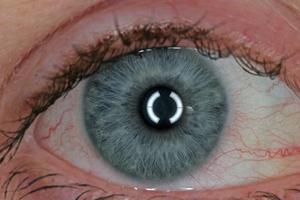BiometricsAging process confounds iris recognition biometrics
It is commonly assumed that biometric template aging does not occur for iris biometrics; there may well be a need to examine this assumption; two University of Notre Dame scientists found that the rate at which a state-of-the-art, commercial iris-matching software system failed to match two images of the same iris — known as the false non-match rate — increased by 153 percent over three years

Irises undergo changes as they age // Source: utah.edu
It is commonly assumed that biometric template aging does not occur for iris biometrics. There may well be a need to examine this assumption.
Two University of Notre Dame scientists, Samuel P. Fenker and Kevin W. Bowyer, compared the match score distribution for short time-lapse iris image pairs, with a mean of approximately one month between the enrollment image and the verification image, to the match score distributions for image pairs with one, two, and three years of time lapse. More specifically, they used state-of-the-art, commercial iris-matching software to measure differences in the software’s performance when comparing more than 20,000 different images of 644 irises, taken between 2008 and 2011. The authors compared the quality of a match between two images of the same iris which were recorded roughly a month apart, to pairs of images taken one, two, or three years apart.
They found clear and consistent evidence of a template aging effect which is noticeable at one year and which increases with increasing time lapse.
They note that for a state-of-the-art iris matcher, and three years of time lapse, at a decision threshold corresponding to a one in two million false match rate, they observed an 153 percent increase in the false non-match rate, with a bootstrap estimated 95 percent confidence interval of 85 percent to 307 percent.
Nature quotes Bowyer to say that with iris recognition now being used at border control in countries such as the United Arab Emirates and the United Kingdom, the findings of the study have huge implications. “At the very least, it could cause delays if people have to be scanned again. At worst, it implies that people might increasingly be able to evade detection when moving between countries,” Nature notes.
What is surprising, on reflection, is why we have accepted so readily the notion that irises were immune to the vicissitudes of time. Bowyer’s view is that it comes down to an incorrect and optimistic assumption made at the outset of iris biometrics. “This assumption was repeated often enough, and in a convincing enough manner until it became fact,” he told Nature.
Bowyer stresses the need to develop iris-recognition algorithms which are less affected by ageing. “The development of ageing-resistant algorithms for iris biometrics has not been studied at all. In contrast, in the face-recognition research community, there is a lot of work on developing algorithms to match faces in the presence of significant ageing,” he says.
— Read more in Samuel P. Fenker and Kevin W. Bowyer, “Analysis of Template Aging in Iris Biometrics” (Department of Computer Science and Engineering, Notre Dame University,2012; the paper will be presented at the IEEE Computer Vision and Pattern Recognition Conference, 16-21 June 2012, Providence, Rhode Island); see also Duncan Graham-Rowe, “Ageing eyes hinder biometric scans,” Nature (25 May 2012) (doi:10.1038/nature.2012.10722)
